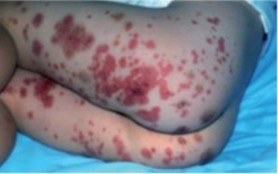(Finkelstein's disease, Seidlmayer's disease)
Rapid appearance, in children under 2 years of age, of target rounded purpuric lesions, associated with edema not taking the cup initially, localized to the extremities. It is more common in boys (70 %). There is often moderate fever (50 %), arthralgia, microscopic hematuria or proteinuria. This disease remains most often benign, without visceral involvement and the diagnosis is clinical. Sometimes an episode nasopharyngeal infection is noted in the previous days suggesting a viral etiology (CMV, adenovirus, herpes, coxsakie). It could be a minimal form of rheumatoid purpura. There is a clear discrepancy between the good general condition of the patient and the profuse and spectacular appearance of the lesions. There are no specific biological signs and histological analysis of the lesions is most often nonspecific (sometimes there is nonspecific leukocytoclastic vasculitis).
The clinical monitoring of these children must be rigorous in the first days but the complications are exceptional (small risk of acute intussusception). The usual evolution is spontaneous regression in about ten days. Treatment is symptomatic and consists in careful monitoring of the child's general condition. A fever, the extension of the purpuric lesions and especially signs of deterioration of the general condition can evoke a diagnosis of purpura fulminans. Another differential diagnosis is acute hemorrhagic or ecchymotic urticaria.

Anesthetic implications:
difficult vascular access; check hemoglobin and platelet levels (reactive thrombocytosis is usual)
Reference:
- Bodak N.
Savoir reconnaître l’oedème aigu hémorragique du nourrisson.
Réalités pédiatriques 2013 ; 181 : 42-3.
- Tumminello M, Lo Scalzo L, Gangemi A, et al.
Acute hemorrhagic edema of infancy (AHEI): alarming cutaneous presentation of a benign and self-limited disease.
Clin Case Rep. 2022;10:e06383. doi: 10.1002/ccr3.6383
Updated: January 2023